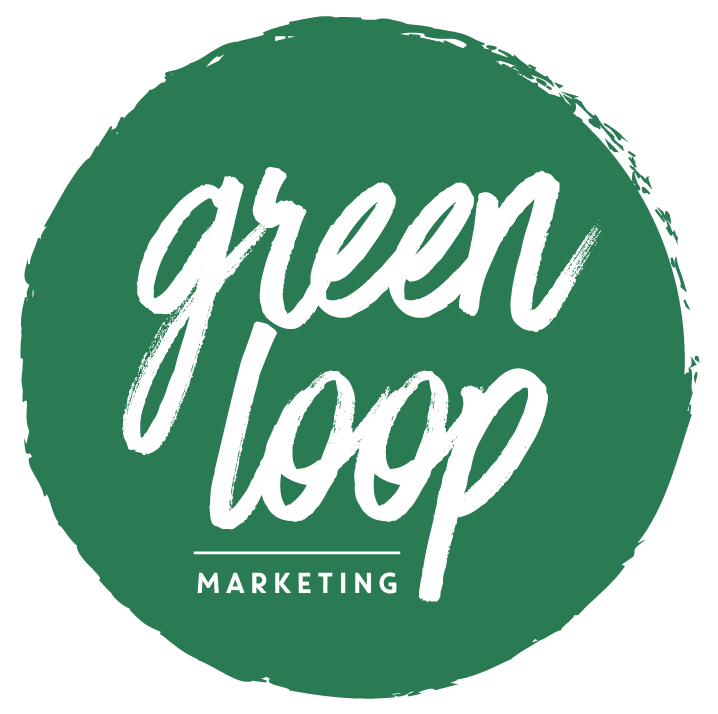5 Simple Ways To Make Your Content More Visually Engaging
By Jenny Tod of Jenny Tod Creative + Indie Coffee Roasters
What if I told you there were ways to create more visually engaging content without spending a dime? I’m often asked about simple and practical methods to enhance a company’s brand identity without bringing on a designer or breaking the bank, so in support of Green Loop Marketing’s mission to help equip and contribute to the growth of local businesses, I’d love to share how to take the incredible content you curate and communicate its value visually.
1.) Typographical Hierarchy
Particularly in presentation decks or longer content pieces, typographical hierarchy keeps things dynamic. Online readers generally skim content searching for phrases with relevance and straight-forward insight, so ensuring the use of titles and subtitles, bolded and italicized text to help break up your copy and assign a visual rhythm to the piece results in more easily digestible content.
We created individual product cards for one of our clients, Integrated Sports Nutrition. The variation of fonts, sizes, and emphases help to differentiate the various content segments, and the bolded phrases on the more copy-heavy side help draw the reader’s attention to the most important points in the text. Intentionally bringing personality and hierarchy into your content allows you to share a lot of information without boring or overloading your readers.
2.) Graphics and Icons
Another great way to drive engagement is by incorporating graphics and icons into your content. Highlight key phrases of your content through designed pull quotes, include a relevant illustration from an artist who has given you permission to share their work (with credit) or bring increased attention to a series of ideas through iconography.
Not only do these things allow you to reiterate an idea through imagery, they provide an additional learning style to those visual learners in your audience. The Noun Project, Canva, iStock, and Icons8 are incredible resources for visuals and iconography.
In our monthly emails, we make it a point to break up content segments with a relevant series of icons to help visually represent the information we’re sharing. For example, we paired the icons above with a list of five ways to stay energized in the workplace. Not only do these give your readers a break from reading copy, but it undoubtedly adds character and energy to your content.
3.) Color
To enhance the overall mood and experience of your content, try adding in some color. Do so sparingly and intentionally; background colors, inverted text, and keyword highlights throughout a piece can add personality and keep your audience interested in your content. Monochromatic illustrations, colorful data visualization, even high quality color photographs can go a long way by adding warmth and dimension to the material.
When designing Lessonly’s 2017 trends report, we took a colorful yet sophisticated approach through vibrant graphics, colorful photo overlays, and the use of both light and dark backgrounds allowing the colors to really shine. When it comes to long-content pieces, breaking things up with eye-catching colors and visuals will help keep your audience engaged and joyful.
4.) Infographics In Place of Copy
Are you commonly issuing timelines, research studies, processes or step-by-step instructions in your content? Try sharing your main points through infographics. As demonstrated through this visual we created to tell the story of the coffee supply chain for Indie Coffee Roasters, infographics are not only more visually engaging, but they help to explain extensive processes in an aesthetic and straightforward manner.
Don’t have design resources at your fingertips? Not to worry. Consider using Piktochart, Visme, or Canva to create infographics, layouts, graphics and other visuals we’ve mentioned thus far both simply and intuitively.
5.) Videos and Photos
If pictures are worth a thousand words, why not use them? Embedding photos and videos into your content is one of the best ways to visually communicate information. Make sure, however, that the images you use are of professional quality; though smartphones have made it very easy to capture high quality images, you can also take advantage of some free stock photo sites, such as Unsplash, Pixabay, or Gratisography, that will provide you with high-quality, royalty-free images.
I knew I wanted to bring vibrance and fun to the headshots I used of my friend Jordan and I to promote our children’s book, “Brunch, Brunch Baby!”. I created a GIF from individual images of us both, which brings movement to the page and allows us the chance to communicate more of our personality than we would otherwise. Giphy.com is the perfect way to create one of these on your own!
Additionally, videos are ever-increasing in their prevalence in newsletters, social media and websites. I’ve discovered that my audience engages much more with the design process time-lapses I publish than with the final graphics of the same artwork. Whether you use videos to share stories, record tutorials, answer FAQ’s or just talk through what you’re working on, start to brainstorm how you might be able to incorporate video footage into your content.
Final Thoughts
As you think through which methods could be helpful to work into your content, let me encourage you to first think through what your target audience would like to see. Do they enjoy bold colors or more neutral tones? Do they enjoy behind-the-scenes previews, or do they need guidance in regards to what already exists? This approach towards visual content creation will guide you to incorporate elements that truly speak to the individuals you are trying to reach, and in doing so, they’ll have a much greater impact.
This post was written by fantastic Jenny Tod of Jenny Tod Creative + Indie Coffee Roasters. Jenny's work is clever and creative, and you'll always catch her working with cool clients. Thanks for sharing your design savvy with us, Jenny!





